Circadian plasticity in photoreceptor cells controls visual coding efficiency in Drosophila melanogaster
- PMID: 20169158
- PMCID: PMC2821403
- DOI: 10.1371/journal.pone.0009217
Circadian plasticity in photoreceptor cells controls visual coding efficiency in Drosophila melanogaster
Abstract
In the fly Drosophila melanogaster, neuronal plasticity of synaptic terminals in the first optic neuropil, or lamina, depends on early visual experience within a critical period after eclosion. The current study revealed two additional and parallel mechanisms involved in this type of synaptic terminal plasticity. First, an endogenous circadian rhythm causes daily oscillations in the volume of photoreceptor cell terminals. Second, daily visual experience precisely modulates the circadian time course and amplitude of the volume oscillations that the photoreceptor-cell terminals undergo. Both mechanisms are separable in their molecular basis. We suggest that the described neuronal plasticity in Drosophila ensures continuous optimal performance of the visual system over the course of a 24 h-day. Moreover, the sensory system of Drosophila cannot only account for predictable, but also for acute, environmental changes. The volumetric changes in the synaptic terminals of photoreceptor cells are accompanied by circadian and light-induced changes of presynaptic ribbons as well as extensions of epithelial glial cells into the photoreceptor terminals, suggesting that the architecture of the lamina is altered by both visual exposure and the circadian clock. Clock-mutant analysis and the rescue of PER protein rhythmicity exclusively in all R1-6 cells revealed that photoreceptor-cell plasticity is autonomous and sufficient to control visual behavior. The strength of a visually guided behavior, the optomotor turning response, co-varies with synaptic-terminal volume oscillations of photoreceptor cells when elicited at low light levels. Our results show that behaviorally relevant adaptive processing of visual information is performed, in part, at the level of visual input level.
Conflict of interest statement
Figures
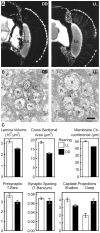
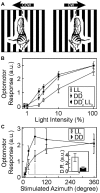
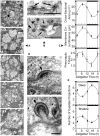

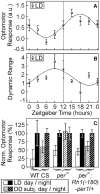
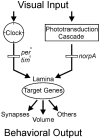
Similar articles
-
CRY-dependent plasticity of tetrad presynaptic sites in the visual system of Drosophila at the morning peak of activity and sleep.Sci Rep. 2020 Oct 23;10(1):18161. doi: 10.1038/s41598-020-74442-w. Sci Rep. 2020. PMID: 33097794 Free PMC article.
-
Circadian control of dendrite morphology in the visual system of Drosophila melanogaster.PLoS One. 2009;4(1):e4290. doi: 10.1371/journal.pone.0004290. Epub 2009 Jan 28. PLoS One. 2009. PMID: 19173003 Free PMC article.
-
Hofbauer-Buchner eyelet affects circadian photosensitivity and coordinates TIM and PER expression in Drosophila clock neurons.J Biol Rhythms. 2007 Feb;22(1):29-42. doi: 10.1177/0748730406295754. J Biol Rhythms. 2007. PMID: 17229923
-
A one-day journey to the suburbs: circadian clock in the Drosophila visual system.FEBS J. 2025 Feb;292(4):727-739. doi: 10.1111/febs.17317. Epub 2024 Nov 1. FEBS J. 2025. PMID: 39484992 Free PMC article. Review.
-
Light input pathways to the circadian clock of insects with an emphasis on the fruit fly Drosophila melanogaster.J Comp Physiol A Neuroethol Sens Neural Behav Physiol. 2020 Mar;206(2):259-272. doi: 10.1007/s00359-019-01379-5. Epub 2019 Nov 5. J Comp Physiol A Neuroethol Sens Neural Behav Physiol. 2020. PMID: 31691095 Free PMC article. Review.
Cited by
-
Sleep, clocks, and synaptic plasticity.Trends Neurosci. 2014 Sep;37(9):491-501. doi: 10.1016/j.tins.2014.06.005. Epub 2014 Aug 1. Trends Neurosci. 2014. PMID: 25087980 Free PMC article. Review.
-
Changes in neuronal CycD/Cdk4 activity affect aging, neurodegeneration, and oxidative stress.Aging Cell. 2015 Oct;14(5):896-906. doi: 10.1111/acel.12376. Epub 2015 Jul 29. Aging Cell. 2015. PMID: 26219626 Free PMC article.
-
CRY-dependent plasticity of tetrad presynaptic sites in the visual system of Drosophila at the morning peak of activity and sleep.Sci Rep. 2020 Oct 23;10(1):18161. doi: 10.1038/s41598-020-74442-w. Sci Rep. 2020. PMID: 33097794 Free PMC article.
-
Glia-related circadian plasticity in the visual system of Diptera.Front Physiol. 2013 Aug 23;4:36. doi: 10.3389/fphys.2013.00036. eCollection 2013. Front Physiol. 2013. PMID: 23986707 Free PMC article.
-
Mmp1 processing of the PDF neuropeptide regulates circadian structural plasticity of pacemaker neurons.PLoS Genet. 2014 Oct 30;10(10):e1004700. doi: 10.1371/journal.pgen.1004700. eCollection 2014 Oct. PLoS Genet. 2014. PMID: 25356918 Free PMC article.
References
-
- Chamberlain SC, Barlow RB., Jr Light and efferent activity control rhabdom turnover in Limulus photoreceptors. Science. 1979;206:361–363. - PubMed
-
- Meister M, Berry MJ., II The neural code of the retina. Neuron. 1999;22:435–450. - PubMed
-
- Barth M, Heisenberg M. Vision affects mushroom bodies and central complex in Drosophila melanogaster. Learn Memory. 1997;4:219–229. - PubMed
-
- Rybak J, Meinertzhagen IA. The effects of light reversals on photoreceptor synaptogenesis in the fly Musca domestica. Europ J Neurosci. 1997;9:319–333. - PubMed
Publication types
MeSH terms
Substances
LinkOut - more resources
Full Text Sources
Molecular Biology Databases

